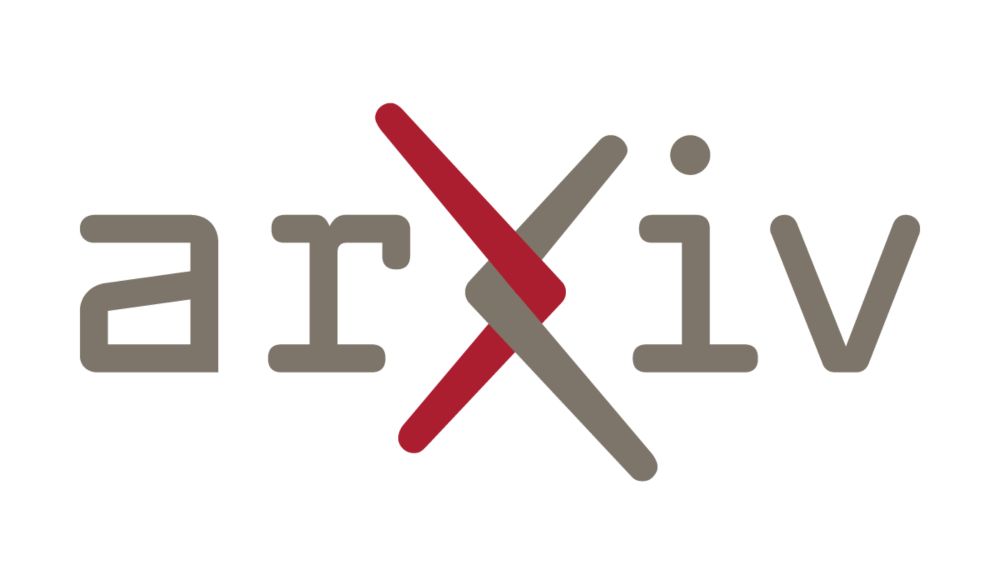Thanks!!!
31.10.2025 15:12 — 👍 0 🔁 0 💬 0 📌 0
Thanks, Jake!!
31.10.2025 13:56 — 👍 0 🔁 0 💬 0 📌 0
We hope this is just the start at looking at these population-level trends, now with more robust and reliable measurements. We'll continue to collect measurements as they become available and update the table. We plan to extend this to include free retrieval results (e.g., H2O, CO2 measurements).
31.10.2025 13:35 — 👍 4 🔁 0 💬 1 📌 0

Even though the trends are a bit offset, the transit and eclipse spectroscopy samples show very consistent mass-metallicity slopes! Both are steeper than the Solar System trend - perhaps interesting... All this is also consistent with interior bulk metallicity inferences.
31.10.2025 13:35 — 👍 2 🔁 0 💬 1 📌 0

C/H versus planet mass, showing increasing metallicity towards smaller planet masses.
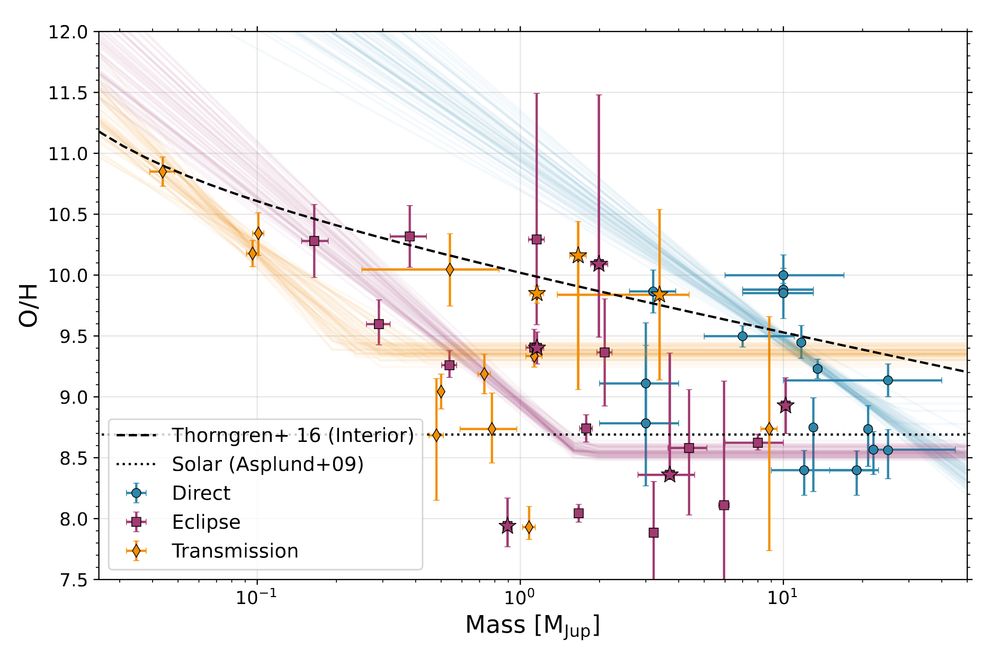
Same as left, but for O/H versus mass.
One of the highlights is the planet mass-(atmospheric) metallicity trend. While such a trend was somewhat controversial with HST measurements, this newer sample shows a much cleaner relationship. With ExoComp, we can break it down between O/H and C/H and compare directly to the Solar System.
31.10.2025 13:35 — 👍 2 🔁 0 💬 1 📌 0

Planet metallicity versus equilibrium temperature.
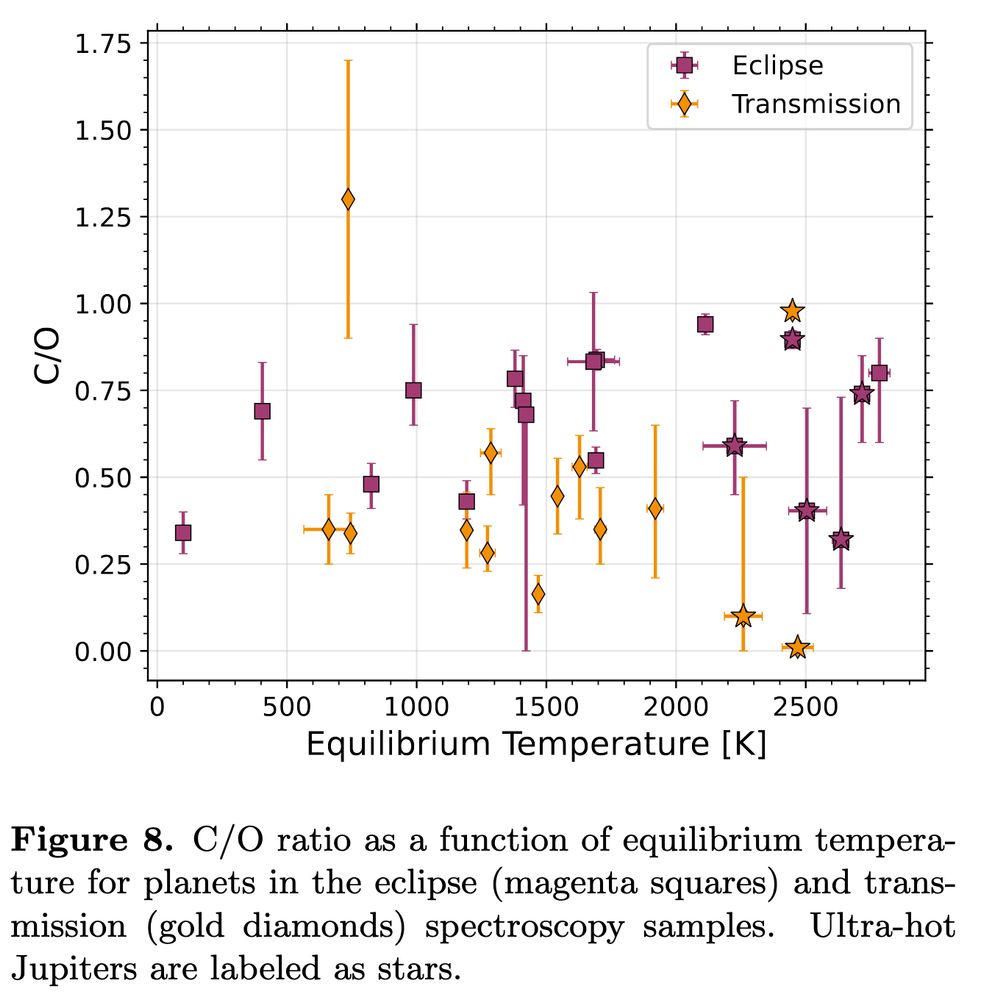
C/O versus equilibrium temperature. No trend is seen.
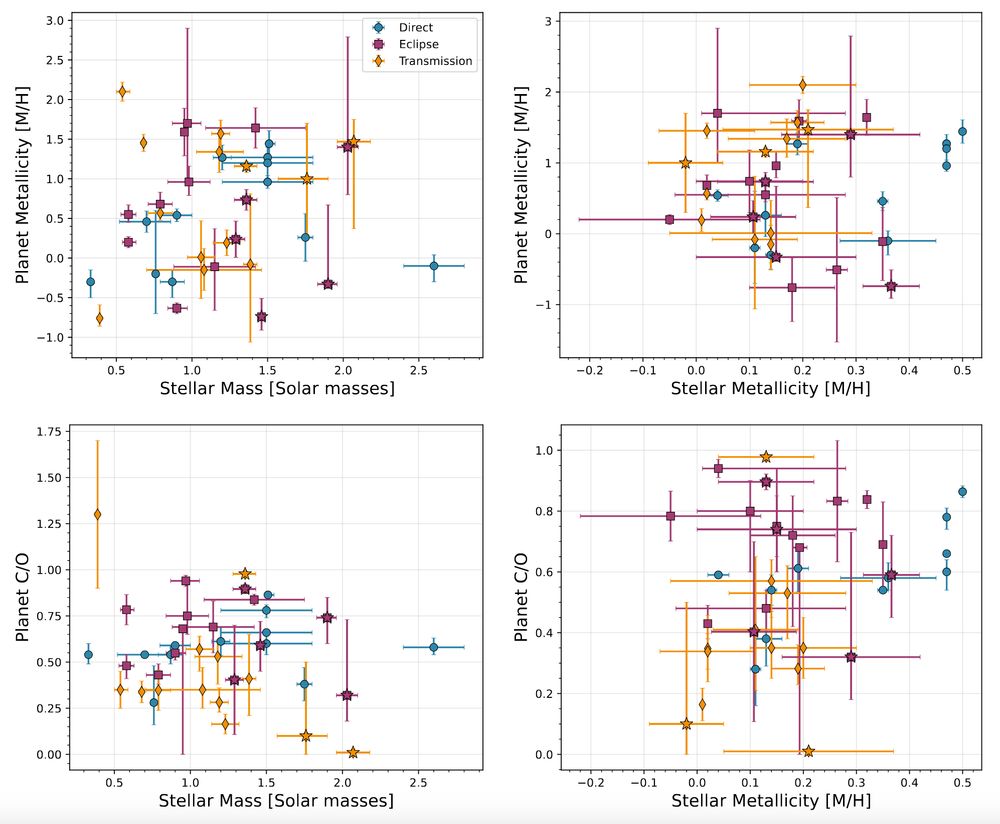
4 panel plots showing planet metallicity and C/O versus stellar metallicity and mass. No obvious trends are seen.
There don't seem to be obvious trends or correlations between planet metallicity, C/O, temperature, stellar metallicity, or stellar mass. But carbon-dominated C/O > 1 planets appear to be rare, if any exist at all!
31.10.2025 13:35 — 👍 2 🔁 0 💬 1 📌 0
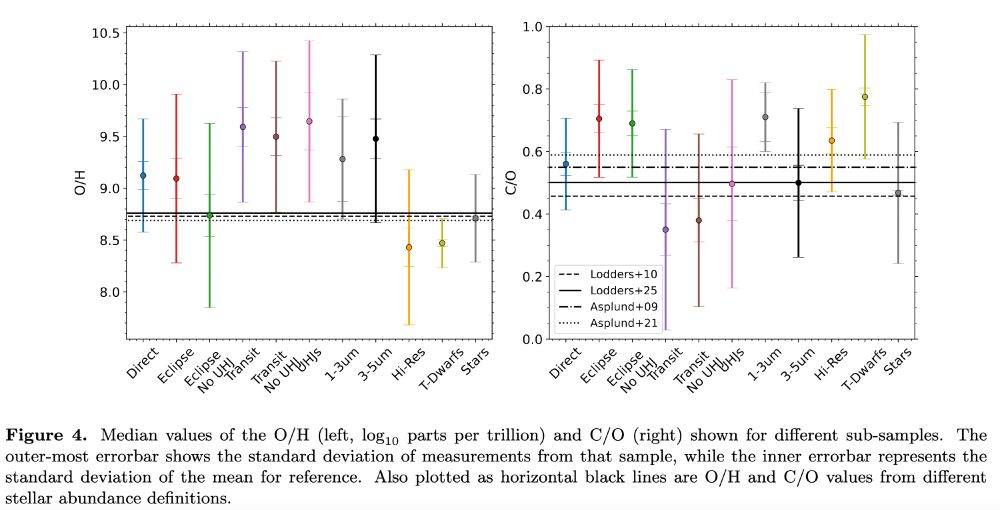
Left: A plot of O/H versus sub-sample (direct spectroscopy, eclipse spectroscopy, etc.). Right: The same but C/O versus sub-sample. Transit spectroscopy shows low C/O.

A plot showing C/O versus metallicity.
After we standardize the 65 atmosphere measurements from JWST and 8m-class telescopes, we can look for trends! And we see some surprises...
The first was that exoplanets measured by transit spectroscopy have low C/O compared to those measured in eclipse. It's not obvious why.
31.10.2025 13:35 — 👍 2 🔁 0 💬 1 📌 0

A logo with text "ExoComp" with a robot scanning the "O".
We've collected 65 individual exoplanet atmosphere composition measurements to look for population-level trends 🔭 #exoplanets
To do this, we had to create a toolkit to standardize between definitions of . We call it ExoComp. (Yes, that's a Star Trek reference 😀).
31.10.2025 13:35 — 👍 15 🔁 4 💬 3 📌 1
Even back in 1850, the biomass of humans matched that of all wild land animals? Not what I would have thought!
30.10.2025 14:49 — 👍 2 🔁 0 💬 0 📌 0
Now extended to Monday 10/20, FYI!
16.10.2025 18:24 — 👍 0 🔁 0 💬 0 📌 0
The last day to register for STScI's fall workshop is today!
www.stsci.edu/contents/eve...
03.10.2025 13:09 — 👍 0 🔁 0 💬 0 📌 0
A leading Democrat in the Senate just released an important report documenting how NASA has been working to implement the president's proposed budget, not Congressionally approved funds, in slashing missions. Read more ⬇️
29.09.2025 14:13 — 👍 247 🔁 126 💬 4 📌 5

An example fit to a JWST/MIRI F1500W eclipse observation of GJ 3929b collected by the Rocky Worlds DDT Program.
New HLSP: First results from the Rocky Worlds DDT program are now available at MAST! This release includes calibrated light curves, model fits, preliminary eclipse depth estimation, and auxiliary data for GJ 3929 b. archive.stsci.edu/hlsp/rocky-w... #HLSP #RockyWorlds #JWST #HST #Exoplanets #MAST 🔭
17.09.2025 18:29 — 👍 11 🔁 5 💬 0 📌 3
Registration is open now for our fall workshop on Atmospheric Escape and Replenishment in Planetary Systems!
🔭 #exoplanets
10.09.2025 16:24 — 👍 3 🔁 2 💬 0 📌 1

Rocky Worlds DDT Updates: Final Target List and Virtual Information Session
The Rocky Worlds DDT has published our final target list. Join us for an information session on September 15 to learn more about the 9 targeted planets and the goals of the program.
🔭 #exoplanets
04.09.2025 14:26 — 👍 26 🔁 10 💬 0 📌 0

The application to join the LPL Planetary Sciences PhD program is now open! Visit lpl.arizona.edu/admissions for more information.
25.08.2025 21:33 — 👍 6 🔁 6 💬 1 📌 0
Yeah! In the paper we estimated something a bit sub-solar for the heavy element abundance, but it gets tricky fast because lots of different things can absorb in the UV, while photochemistry, dissociation, and escape can all confound abundance measurements.
16.08.2025 13:40 — 👍 0 🔁 0 💬 0 📌 0

Two histograms showing the posterior constrain on limb asymmetries in the white light curve and NUV spectrum. The NUV spectrum (0.2-0.4) appears to show positive evidence for a limb asymmetry.
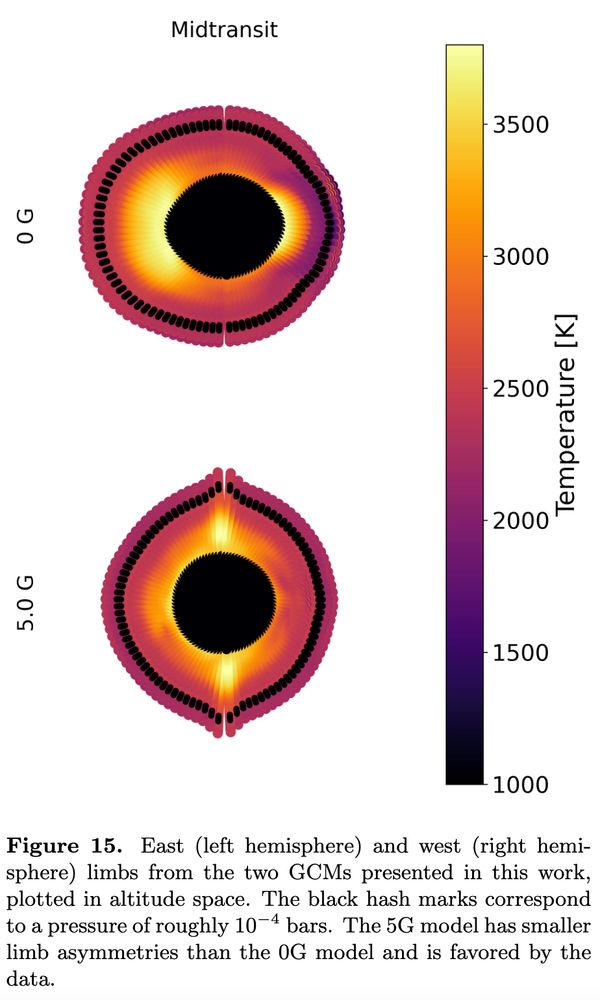
Two 2D slices of the 3D global-circulation model, showing the temperature in color for the 0 Gauss and 5.0 Gauss magnetic field models. The 0 Gauss model shows more asymmetry than the 5.0 G model.
We find tentative evidence for a limb asymmetry in the huge NUV feature. 3D GCM models (with mag fields!) by @hayleybeltz.bsky.social to show that the data is (tentatively) more consistent with a model *with* a magnetic field than without!
More obs of, e.g., the hot spot offset, could help.
15.08.2025 13:24 — 👍 5 🔁 0 💬 1 📌 0
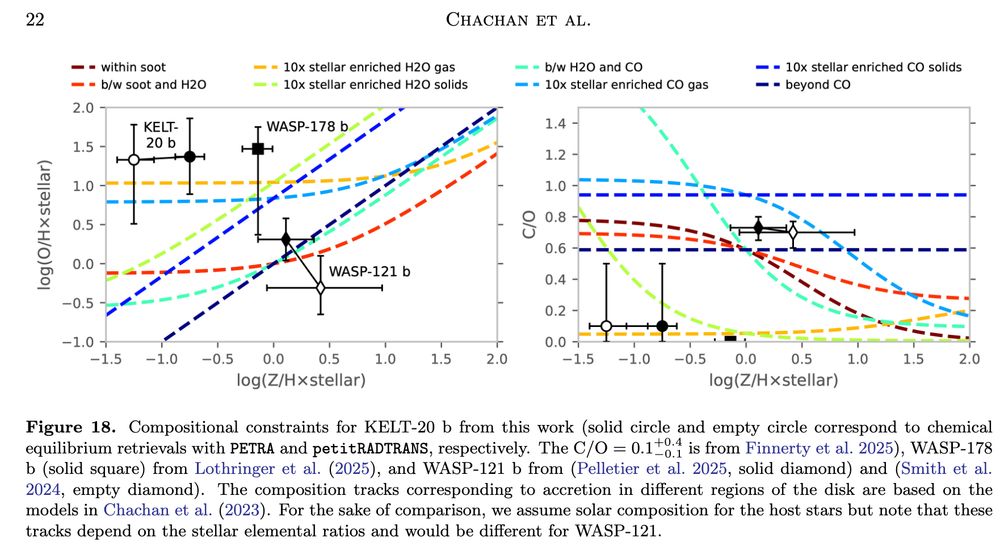
Two plots showing the composition constraints from KELT-20b (O/H versus Z/H and C/O versus Z/H), alongside possible formation scenarios. KELT-20b, WASP-178b, and WASP-121b are all plotted as well. KELT-20b is consistent with the accretion of volatile-enriched gas and/or solids.
KELT-20b is unique compared to other UHJs in that it appears to be well-aligned with the rotation of its host star, perhaps indicating something unique about its formation.
Our measurements suggest the accretion of volatile-rich solids or gas, though therm dissociation makes the measurement hard.
15.08.2025 13:24 — 👍 1 🔁 0 💬 1 📌 0

A plot of normalized spectra of various planets showing transit radius (normalized to the equilibrium scale height) versus wavelength. Planets above ~2000K appear to have large NUV absorption, while planets <2000K do not.
Free retrievals prefer fitting the NUV feature with Fe II rather than SiO, though SiO was preferred in chemical equilibrium. Either way, it appears that enormous NUV absorption may not be rare among ultra-hot planets.
15.08.2025 13:24 — 👍 2 🔁 0 💬 1 📌 0
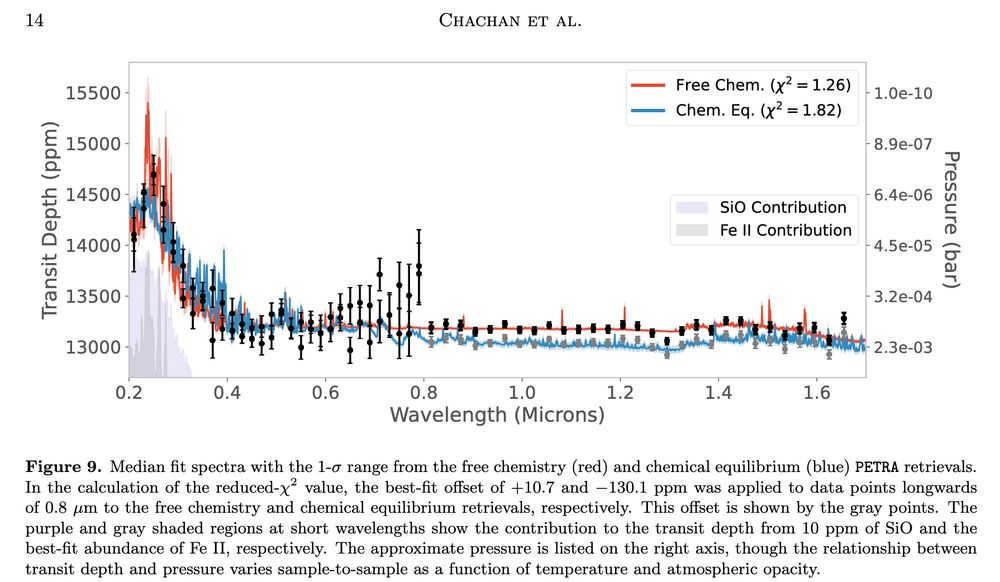
A plot of a spectrum of transit depth versus wavelength showing large NUV absorption and weak H2O absorption at NIR wavelengths.
I'm very excited to be able to share Yayaati Chachan's Hubble/WFC3 transit spectrum of ultra-hot Jupiter KELT-20b.
Using *all* of WFC3's grisms, we get a 0.2-1.7 micron spectrum showing absorption by metals at in the UV and only weak absorption by water in the IR. 🔭🪐
15.08.2025 13:24 — 👍 28 🔁 4 💬 2 📌 0

Three panels, each showing a different view of the binary star system Alpha Centauri. The panel on the left is a Digitized Sky Survey image showing a single bright blue point source at the center of a black image with stars scattered throughout. The center of this source is outlined with a vertical box, tilted slightly to the left, with two diagonal lines leading to the second panel. The 2nd panel is a Hubble image that shows 2 white stars with 4 diffraction spikes each against a black background. The top star is labeled Alpha Cen B and the bottom Alpha Cen A. Alpha Cen A is outlined with a white square with 2 diagonal lines leading to the 3rd panel at the furthest right, which shows a Webb image of the star. An orange star icon and central black circle outlined in white marks the location of Alpha Cen A. A large white circle outlines a blurry red-toned field that surrounds the location of the star. A bright orange blob at 9 o’clock in relation to the star is labeled “S1” and circled.
NEWS: Will you be my neighbor? #NASAWebb has found strong evidence of a gas giant planet orbiting Alpha Centauri A, a star in the stellar system closest to our own sun: webbtelescope.pub/4oyLiQa 🔭 🧪
07.08.2025 15:03 — 👍 47 🔁 19 💬 1 📌 0

Atmospheric Escape and Replenishment in Planetary Systems Workshop
Abstracts close this Friday for the Fall 2025 STScI Science Workshop on Atmospheric Escape and Replenishment. We'd love to see you in Baltimore in November!
Check it out and let me know if you've any questions. 🔭 #exoplanets
www.stsci.edu/contents/eve...
14.07.2025 16:38 — 👍 8 🔁 2 💬 0 📌 1
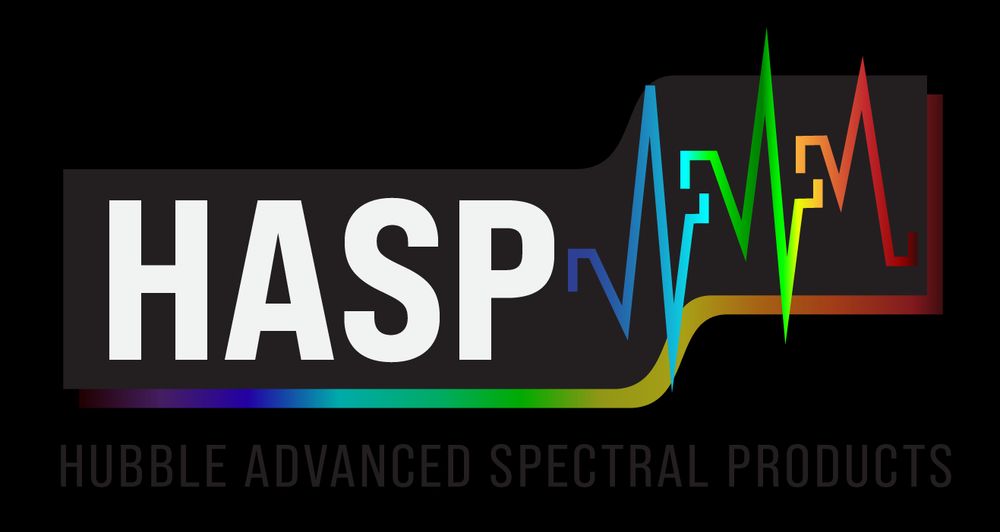
The logo for the Hubble Advanced Spectral Products, or HASP. White lettering with a rainbow border below. To the right is a set of stylized spectra ranging from violet to red that are in the process of "hooking" together. A hasp is a latching mechanism, which is similar to what HASP does--link different gratings from HST spectroscopy together.
Like #Hubble spectra, but it's hard to access? My working group @stsci.edu launched the Hubble Advanced Spectral Products, joining COS and STIS spectra across different modes and instruments for every HST program for the first time 🧪🔭https://archive.stsci.edu/missions-and-data/hst/hasp (1/4)
25.06.2025 16:33 — 👍 25 🔁 7 💬 1 📌 1
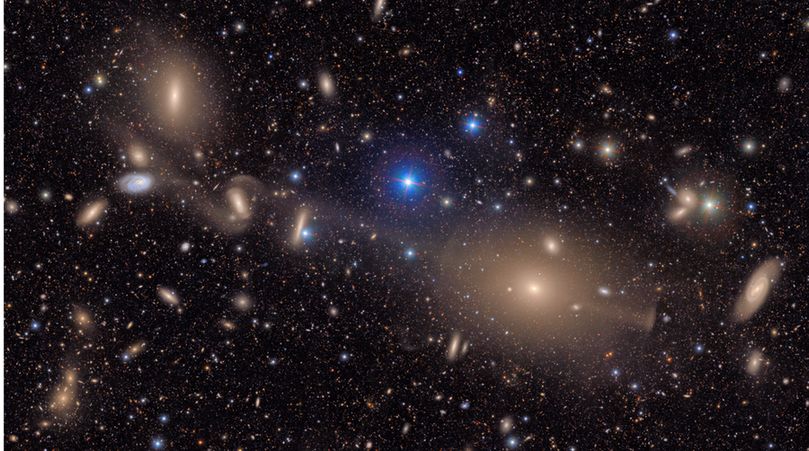
A sprawling, textured field of galaxies scattered across the deep black of space. It is filled with the delicate smudges and glowing cores of galaxies of many shapes, sizes and colors, as well as the bright multi-colored points of stars. The image focuses on a collection of interacting galaxies connected by delicate streams of stars. At top center lies a large elliptical galaxy that is dense and smooth, like a polished stone glowing with golden light. Like delicate spider silk or stretched taffy, these stellar bridges link the large elliptical to the few larger galaxies beneath, evidence of past collisions.
All throughout the image, thousands of galaxies gather in clusters or are spread throughout, like glittering gems strewn on a table. Some are sharp-edged and spiral, like coiled ribbons; others round and diffuse, like polished pebbles. Still others are just smudges of various colors against the black of space. The background is peppered with pinpoint stars in reds, yellows, and blues, crisp against the velvet black.
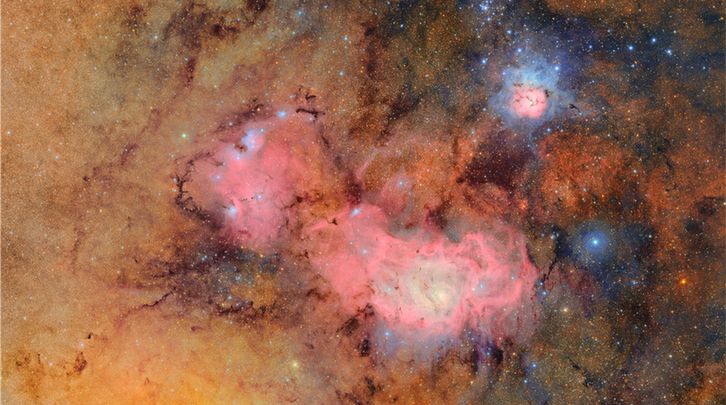
A cosmic tapestry of glowing tan and pink gas clouds with dark dust lanes. In the upper right, the Trifid Nebula resembles a small flower in space. Its soft, pinkish gas petals are surrounded by blue gas, and streaked with dark, finger-like veins of dust that divide it into three parts. It radiates a gentle, misty glow, diffuse and soft like the warmth of breath on a cold hand. To the lower left, the much larger Lagoon Nebula stretches wide like a churning sea of magenta gas, with bright blue, knotted clumps sprinkled throughout where new stars are born. Both nebulae are embedded in a soft tan backdrop of gas that is brighter on the left than on the right, etched with dark tendrils of dust and sprinkled with the pinpricks of millions of stars.
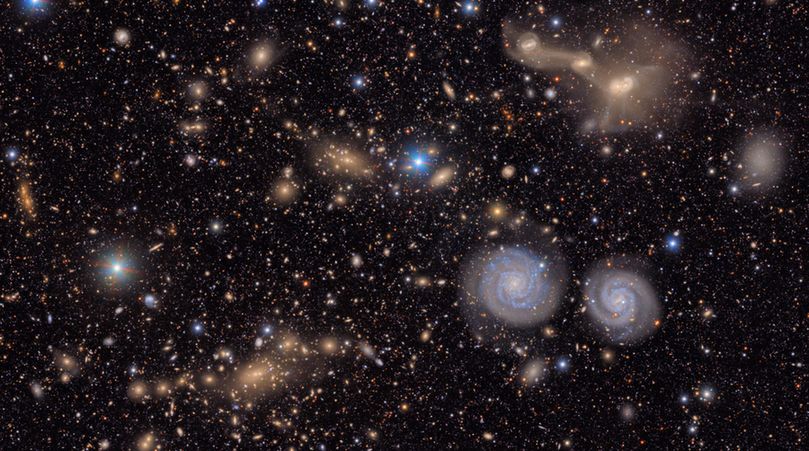
A sprawling, textured field of galaxies scattered across the deep black of space. It is filled with the delicate smudges and glowing cores of galaxies of many shapes, sizes and colors, as well as the bright multi-colored points of stars. To the lower left is a region filled with the hundreds of golden glittering gems of a distant galaxy cluster. In the foreground, below and right of center, two blue spiral galaxies look like eyes beneath the entangled mass of a triple galaxy merger in the upper right. A few bright blue points of foreground stars pierce the glittering tapestry.
All throughout the image, thousands of galaxies gather in clusters or are spread throughout, like glittering gems strewn on a table. Some are sharp-edged and spiral, like coiled ribbons; others round and diffuse, like polished pebbles. Still others are just smudges of various colors against the black of space. The background is peppered with pinpoint stars in reds, yellows, and blues, crisp against the velvet black.
Introducing...your sneak peek at the cosmos captured by NSF–DOE Vera C. Rubin Observatory!
Can you guess these regions of sky?
This is just a small peek...join us at 11am US EDT for your full First Look at how Rubin will #CaptureTheCosmos! 🔭🧪
#RubinFirstLook
ls.st/rubin-first-look-livestream
23.06.2025 04:06 — 👍 703 🔁 333 💬 22 📌 105
🇸🇪 Exoplanet atmospheres + chemistry + formation at Uppsala University 🪐🔭 Also into astrobiology, policy, climate, equality/EDI, and scicomm ✨ (she/her) – linnboldtchristmas.wordpress.com
interested in directly imaging exoplanets and studying solar system analogs • postdoc at MIT • i love hiking, cooking, and my cats!
snhasler.github.io
CHNOPS in ferruginous saline. Multicellular aerobic chemoheterotroph; symbiont of photosynthetic autotrophs. Descendant of stardust; aspiring good ancestor. Senior Editor, Scientific American. Signal: @lee_billings.81
SpacePolicyOnline.com is your first stop for news, information and analysis about civil, commercial, and national security space programs. Marcia Smith is the editor.
Astrophysicist, postdoc, cat mom, she/her kamberschwarz.com
My goodness: It's full of planets!
European in Graz.
Often to be found at Space Research Institute at Graz!
(Yes, Graz hosts the Austrian Space Research Institute. It's awesome, check it out!)
(Ja, Graz hat die Weltraumforschung und sie ist toll)
Academic wanderer, all the atmospheres, dad, husband, runner. He/him.
Postdoc at Vanderbilt University working on stellar magnetic activity and its impacts on planetary atmospheres. (He/him/his)
Astrophysics PhD student at the university of Oxford studying exoplanet atmospheres
Assistant professor at the Institute of Science Tokyo, Japan | Working on characterizing exoplanet atmosphere.
https://astrostevanus.github.io
Official account for #ExoclimesVII on July 7-11th 2025 in Montréal, Canada! The ExoSLAM summer school aimed at early career researchers will take place July 3-5
Physics, philosophy, complexity. @jhuartssciences.bsky.social & @sfiscience.bsky.social. Host, #MindscapePodcast. Married to @jenlucpiquant.bsky.social.
Latest books: The Biggest Ideas in the Universe.
https://preposterousuniverse.com/
Atmospheric modeling and retrieval group
Max Planck Institute for Astronomy
Studying planets and moons at University of Arizona Lunar and Planetary Lab. Also cats, nature photography, and life around Tucson. #TeamRadar #BacktoVenus
Physicist/planetary scientist/astrobiologist based at Harvard. Soccer dad in training. Social media native since 2024.
I have arrived.
One existential crisis from being productive.
NYT columnist. Signal: carlzimmer.51
Newsletter: https://buttondown.com/carlzimmer/
Web: http://carlzimmer.com
[This account includes a tweet archive]
Writer, journalist. Science, health. Pandemics, animals. Birder, photographer. Many words, some awards. AN IMMENSE WORLD, I CONTAIN MULTITUDES. Married to Liz Neeley, parent to Typo. he/him
📷 Canon R6mkii + RF 800mm
Edyong.me
Planetary scientist, cat person, book nerd
